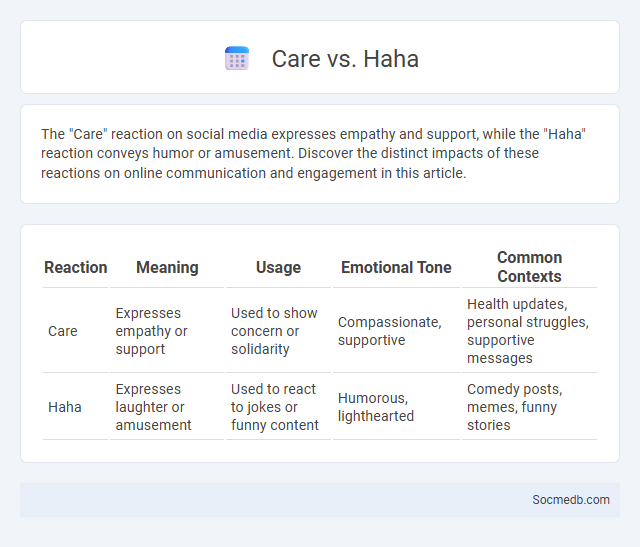
Photo illustration: Care vs Haha
The "Care" reaction on social media expresses empathy and support, while the "Haha" reaction conveys humor or amusement. Discover the distinct impacts of these reactions on online communication and engagement in this article.
Table of Comparison
| Reaction | Meaning | Usage | Emotional Tone | Common Contexts |
|---|---|---|---|---|
| Care | Expresses empathy or support | Used to show concern or solidarity | Compassionate, supportive | Health updates, personal struggles, supportive messages |
| Haha | Expresses laughter or amusement | Used to react to jokes or funny content | Humorous, lighthearted | Comedy posts, memes, funny stories |
Understanding Facebook Reactions: Care vs Haha
Facebook Reactions provide nuanced ways for users to express emotions beyond a simple "Like," with the "Care" reaction symbolizing empathy, compassion, and support, often used during sensitive or challenging posts. The "Haha" reaction conveys amusement and laughter, typically applied to humorous content or light-hearted moments. Understanding these distinctions helps you engage more meaningfully, ensuring your interactions accurately reflect your intentions and resonate with the content shared.
The Evolution of Facebook Reactions
Facebook Reactions evolved from the original "Like" button into a diverse set of emotive responses, including Love, Haha, Wow, Sad, and Angry, introduced in 2016 to enhance user expression and engagement. This expansion allowed users to convey nuanced emotions, driving richer interactions and providing valuable sentiment data for businesses and marketers. Reacts have since influenced content algorithms, shaping personalized news feeds and advertising strategies by reflecting user preferences more accurately.
Care Reaction: Meaning and Usage
Care Reaction is a popular social media emoji used to express empathy, concern, or support, especially during sensitive or emotional posts. It allows you to communicate genuine feelings of care and connection without needing words, making interactions more heartfelt and meaningful. Using the Care Reaction effectively can enhance engagement and convey your attentiveness to friends' and followers' experiences.
Haha Reaction: When Humor Takes Over
The Haha reaction on social media sparks genuine engagement as users express amusement with short, relatable humor that fosters community connection. This reaction drives viral content, encouraging creators to prioritize entertaining and witty posts that resonate deeply with their audience. Understanding how your audience reacts with Haha can enhance your content strategy, amplifying reach and building a loyal following.
Emotional Impact of Care vs Haha
The emotional impact of "Care" reactions on social media often conveys genuine empathy, fostering deeper connections and support during sensitive moments. In contrast, the "Haha" reaction tends to express humor or lightheartedness, which can diminish serious content's emotional gravity. Understanding these nuanced responses helps brands and users tailor their communication for more meaningful engagement.
Social Contexts for Using Care and Haha
Social media platforms like Care and Haha create unique social contexts that influence user interactions and emotional expression. Care reactions foster empathy and support, enhancing community bonding and positive reinforcement. Haha responses often serve to inject humor and lighten conversations, balancing emotional dynamics in digital communication.
Common Misinterpretations of Reactions
Social media reactions are often misinterpreted because likes, shares, and comments do not always reflect genuine approval or agreement. Your perceived popularity or message impact can be distorted by automated bots, passive consumption, or social pressure rather than authentic engagement. Understanding the nuances behind reactions helps in accurately assessing the true response of your audience.
Care vs Haha: Influencing Online Conversations
Social media platforms use reaction buttons like Care and Haha to shape online conversations by signaling empathy or humor, directly affecting how users interpret and engage with content. The Care reaction fosters emotional support and community bonding, often leading to more meaningful interactions and increased visibility for posts related to personal stories or struggles. In contrast, the Haha reaction highlights humor and relatability, frequently driving content viral through shares and comments, thus influencing the tone and spread of conversations across networks.
Data Insights: Popularity of Reactions
Data insights reveal that likes and love reactions dominate social media engagement, accounting for over 70% of total interactions on platforms like Facebook and Instagram. Emojis such as (laughing) and (surprised) show high popularity in user comments, driving emotional connection and viral sharing. Analyzing reaction patterns helps brands tailor content strategies, boosting user engagement by 30% on average.
Choosing the Right Reaction: Tips for Effective Engagement
Selecting the appropriate reaction on social media enhances user engagement by conveying genuine emotions and fostering meaningful interactions. Understanding platform-specific reactions, such as Facebook's Like, Love, or Care options, allows for nuanced communication that resonates with content creators and audiences alike. Employing thoughtful reactions increases visibility through algorithmic boosts and cultivates positive online communities.
 socmedb.com
socmedb.com